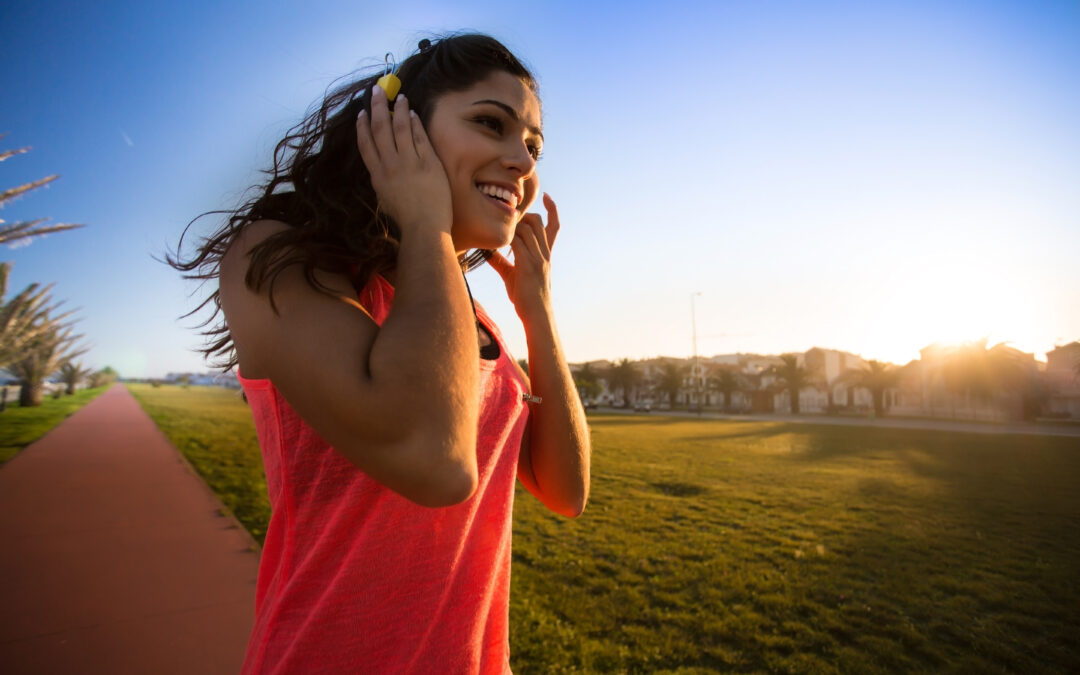What do you think when you hear guided imagery?
If you’re like me, you might think it sounds like pseudoscience. I used to think guided imagery was for people who drink wheat grass shots and go on week-long meditation retreats. I didn’t think it was people who considered themselves Type A.
After doing my research, I realized I was wrong. The science behind guided imagery is solid and it has been used for a wide variety of things ranging from chronic pain, to immune function, and even motivation for physical activity.
My Personal Experience with Guided Imagery
I learned more about this technique in a labor preparation class.
As part of this class, I practiced guided imagery by listening to guided imagery audio a few times per week. The audio included relaxing music and suggestions that I might feel calm and in control.
I visualized myself coping calmly and confidently and thinking of each contraction as a positive thing, as being one step closer to meeting my baby. This type of alternative imagery is common in guided imagery, and replaces the common experience of pain as something to cringe through and endure in agony (with is pretty much what I did my entire first labor experience). After a few months of practicing these techniques 1-2 times per week, I was able to achieve my goal of a positive birth experience without using pain medication.
Recently, I began looking at the research on guided imagery as it relates to food cravings, physical activity and weight loss. After reviewing the evidence, there are clearly lots of opportunities to use guided imagery to help with a number of different goals, including:
- Stress management
- Health habits like healthy eating and exercise
- Weight loss
- Overall wellness
What is Guided Imagery?

Guided imagery is a form of focused relaxation that involves all of the senses. It typically involves breathing and relaxation combined with imagining scenes or scenarios. It might include suggestions or guidance towards feeling a particular way.
For example, it might suggest that you feel increasingly relaxed as you go through the exercise, or calm and confident as you cope with a particular situation (e.g., childbirth, fighting a disease, exercising).
To do guided imagery, you can read a script or listen to an audio recording. You can listen to a script created for general topics (just do a google search for guided imagery relaxation and you will find a ton of free options) or you can create your own script for the specific situation you are dealing with.
Benefits of Guided Imagery

Guided imagery may be used as an add-on treatment for a wide variety of medical conditions. For example, when patients having heart surgery were randomly assigned to guided imagery practice, they had shorter hospital stays, used less pain medications, and reported higher satisfaction with their care (Halpin et al., 2002). It has also been used in many other medical treatments, including but not limited to patients with cancer (Kolcaba and Fox, 1999), chronic pain, and those who have had a stroke (Horrigan, 2002).
It has also been used in helping people improve their athletic performance. One study found that golfers who did guided imagery set higher and more realistic goals and practiced more after the training was over (Martin & Hall, 1995).
The positive effects of guided imagery may even extend to our immune function and other aspects of our biology. A study of breast cancer patients found that after 4 weeks of guided imagery training, patients had improved natural killer cell toxicity, which suggests improved immune function (Lengacher et al., 2008).
Guided Imagery and it’s Effect on Eating and Exercise

More recently, researchers have examined how this strategy might be applied to improve health behaviors like eating and physical activity.
One study randomly assigned participants to one of 4 groups:
- Group 1 listened to a guided imagery CD for 5 minutes per day
- Group 2 listened to a relaxation CD
- Group 3 set “implementation intentions” meaning they wrote down when and where they would exercise
- Group 4 was just asked to “try to exercise” and record it
After 2 weeks, the guided imagery and implementation intentions groups exercised most, with the relaxation group slightly below. All three groups exercised significantly more than the control group (Andersson & Moss, 2011). This study suggests that simply practicing guided imagery increased exercise just as much as implementation intentions, which was already known to help people stick to an exercise routine.
Does Guided Imagery Help with Creating a Sustainable Exercise Habit?
The above study only examined exercise behavior for 2 weeks, but most of us want habit changes for longer than that.
Another study looked at women who exercised minimally who joined an 8 week exercise program. Those who did guided imagery showed increased internal motivation for exercise (Duncan et al., 2012). That is, they started to see exercise as consistent with their identity (“I am an exerciser”, or “I am a fit person”) and also enjoyed exercise more (Duncan et al., 2012).
This means that guided imagery can help us increase internal motivation for exercise, which has been consistently linked to keeping exercise up and losing more weight up to 3 years later (Silva et al., 2011).
Does Guided Imagery Help with Food Cravings?
Yet another study examined using personalized guided imagery for 6 weeks, with participants practicing daily guided imagery scripts for stress relief, addressing a food craving, and for physical activity.
Importantly, those assigned to the guided imagery condition had significantly decreased food cravings and increased exercise over the study time period (Giacobbi et al., 2018) further suggesting that guided imagery can help us develop healthier habits.
The Key Takeaway and the Most Exciting Thing about Guided Imagery

Although its great that guided imagery might help people exercise more over 2, 6, or 8 weeks, the most exciting part is that guided imagery can help increase autonomous, or internal, motivation for change.
This is the holy grail of motivation, because when you are autonomously or internally motivated to do something, you are probably going to keep it up over many years, even if your situation changes or life gets stressful. If we aren’t autonomously motivation to do something, when push comes to shove, we are much more likely to give up the habit.
An Alternative to Change Our Thinking
I spend a LOT of time talking to people about the importance of reflecting on their values and reasons for wanting to change, and considering how exercise or other behaviors are consistent with the person we want to be. One of my previous posts gives the rationale for this, and walks you through a worksheet that shows you how to apply this to a specific behavior you want to change.
But sometimes, thinking about things consciously can only get us so far.
Challenging our Thinking Patterns
People tell me how much they want to improve their health to be around for their children, but when it comes to getting out the door to walk on a regular basis, they get frustrated with themselves that they aren’t doing it consistently.
First, we need to understand what beliefs are operating here. Is the person feeling lack of confidence? Or do they not see themselves as someone who can set a plan and stick to it? Do they hold a belief that they are lazy or undisciplined?
Once that is uncovered, we can try to change it by consciously repeating to ourselves an alternate thought (“I am a strong person who can meet the goals I set for myself”), or looking for the evidence to support an alternative belief.
These techniques absolutely work and this is well-documented by the years of successful treatment of depression, anxiety, and other psychological problems using cognitive-behavioral therapy.
A New Way to Change Our Thinking
But sometimes shifting these beliefs is easier said than done. In those cases, guided imagery can be another tool to help you relax and shift beliefs.
“…it is able to sidestep linear thinking and logical assumptions and send its healing messages straight into the center of the whole person where it can affect unconscious assumptions and jostle defeating self concepts while floating soft, appealing reminders of health, strength, meaning, and hope.”
– Bellerth Naparstek, from her book Invisible Heroes
How Does This Apply to Eating?
It is encouraging to see that guided imagery can help with food cravings (Giacobbi et al., 2008), but even more helpful would be if it could help increase autonomous motivation for eating well. Although I did not find a study specifically looking at this, there’s reason to believe guided imagery could absolutely help with this goal.
Researchers are continuing to look at whether guided imagery might increase internal motivation for weight loss and other health behaviors. There is a study currently underway that is examining this question among Latino adolescents (Weigensberg et al., 2018).
How to Practice Guided Imagery to Meet Your Goals
Assuming I’ve convinced you, let’s talk about the ways you can practice guided imagery:
- You can read a script, or have a script read to you. Check out the 10 minute guided walk I created to help increase internal, autonomous motivation for exercise HERE!
- You can choose a script that addresses a common issue (find a YouTube video on guided imagery relaxation) or you can personalize your guided imagery scripts to fit your specific situation.
Writing Your Own Guided Imagery

Let’s look at how you might write a guided imagery script if you wanted to make a personal audio to increase your motivation for exercise.
In the studies on this type of imagery, participants were asked to imagine themselves in a state where exercise is consistent with their identity (Duncan et al., 2012). The scripts were about 5 minutes long, and had participants imagining themselves preparing to exercise, exercising, and completing the exercise.
Components of a Guided Imagery Script
- Elicit relaxation response: First, the script should elicit the relaxation response, so the first part of the imagery would encourage you to take some deep controlled breaths.
- Imagine with all of your senses: Next, the imagery of the exercise session would have imagine yourself getting ready to exercise, and utilizing all of your senses. What do you see, touch, smell, hear, or taste?
- Add language aimed at shifting thinking patterns and beliefs: For optimal internal motivation, the imagery should help you shift your thinking to more internal motivation for exercise. It might include statements like
- “Imagine yourself completing your exercise session, feeling like you belong,” or
- “This is what it feels like to be an exerciser.”
- Examples of encouragement to feel certain feeling states might include “although you were fatigued the first few weeks, during this session you are noticing how exercise helps you to feel more energized” or
- “You notice that you are feeling more in tune with your body, and wanting to take great care of it moving forward in your day.”
- You are excited for your next exercise session as you are beginning to associate it with self-care and something you really enjoy.”
Shawn, That Sounds Like a Lot of Work, Can You Just Send Me a Good One?
Of course I can. 😉 Just grab my recently created guided walk audio HERE which is aimed at increasing internal motivation for exercise. It’s 10 minutes long and I think you are going to love it. I designed to be listened to on a walk, or even while multi-tasking or sitting (though I highly recommended you take a walk outside if you can).
5 Suprising Ways Guided Imagery Can Help You
So in summary, guided imagery can fixed everything.
Ok, maybe not, but here’s a recap of some of the cool things it can help with:
- Exercise Motivation! Clearly my favorite right now. Check out my free audio and I’d love to hear what you think!
- Reduce Food Cravings. Who couldn’t use this? I plan to make another audio for this down the road, so stay tuned and please join my email list for all the updates.
- Immune Function. To be fair, this is true of other relaxation based exercises too, but regardless, I’m also impressed.
- Pain Control. I can attest to this first hand following my birth experience, but there’s also lots of study to back this up too, of course.
- Athletic Performance. Studied in multiple ways, but high performing athletes are using this. Study cited above is golfers. I should probably let my husband know about this.
And many more!
What Do You Plan to Use Guided Imagery For?
Comment below or contact me at info@drshawnhondorp.com!
Disclaimer/Warning: Please note, that although many can benefit from guided imagery, some people who have a history of psychosis (getting out of touch with reality or having difficulty distinguishing real from the imagination) or who have history of unaddressed traumatic event should consult with a mental health professional before starting this or another relaxation based program. Guided imagery or other non-medical approaches should never be used in place of medical treatment. If you have any of the above concerns, always consult with a medical professional.
References
Andersson, E. K., & Moss, T. P. (2011). Imagery and implementation intention: A randomised controlled trial
of interventions to increase exercise behaviour in the general population. Psychology of Sport and
Exercise, 12, 63–70.
Duncan, L. R., Hall, C. R., Wilson, P. M., & Rodgers, W. M. (2012). The use of a mental imagery intervention to enhance integrated regulation for exercise among women commencing an exercise program. Motivation & Emotion, 36, 452-464.
Giacobbi, P., Long, D., Nolan, R., Shawley, S., Johnson, K. & Misra, R. (2018). Guided imagery targeting exercise, food cravings, and stress: a multi-modal randomized feasibility trial. Journal of Behavioral Medicine, 41, 87-98.
Halpin, L. S., Speir, A. M., CapoBianco, P., & Barnett, S. D. (2002). Guided imagery in cardiac surgery. Outcomes Management, 6, 132-137.
Horrigan, B. (2002). Imagery: The body‟s natural language for healing. Alternative Therapies in Health and Medicine, 8, 80-89.
Kolcaba, K., & Fox, C. (1999). The effects of guided imagery on comfort of women with early stage breast cancer undergoing radiation therapy. Oncology Nursing Forum, 26, 67-72.
Lengacher, C. A., Bennett, M. P., Gonzales, L. et al. (2008). Immune responses to guided imagery during breast cancer treatment. Biological Research for Nursing, 9, 205-214.
Martin, K. A., & Hall, C. R. (1995). Using mental imagery to enhance intrinsic motivation. Journal of Sport and Exercise Psychology, 17, 54-69.
Silva, M., Markland, D., Caraca, E. et al. (2011). Exercise autonomous motivation predicts 3-yr weight loss in women. Medicine and Science in Sport and Exercise, 43, 728-737.
Weigensberg, M. J., Spruijt-Metz, D., FredWen, C K., Davis, J. N. et al (2018). Protocol for the Imagine HEALTH Study: Guided imagery lifestyle intervention to improve obesity-related behaviors and salivary cortisol patterns in predominantly Latino adolescents. Contemporary Clinical Trials, 72, 103-116.

Shawn, I really appreciated your guided imagery audio on Exercise. I’m not a walker or runner (fall risk), but I will be using it for motivation to get on my exercise bike. I also remember that you had a guided imagery script for us in the group sessions last year related to having a mindful approach to eating a meal. I would look forward to having that script as an audio, as well as others related to eating habits, or even to other issues of thought patterns about life stresses and wellness. Anyway, keep up your good and caring work. I’m listening, and believe it or not, I’m actually starting up to act on your advise to start enjoying the process as much as the outcome.
Thanks so much for the feedback and your comment, Marlan! So glad the audio was useful! And yes, audios related to eating and other wellness topics are absolutely in the works so I’m glad to hear they are desired! 🙂